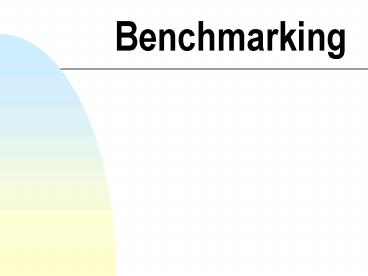Benchmarking - PowerPoint PPT Presentation
1 / 19
Title:
Benchmarking
Description:
'The Value of Benchmarking Is That It Provides a Substitute for the Efficiency ... Task, Activity, Process, Event, Function, Service or Endeavour Is Successful ... – PowerPoint PPT presentation
Number of Views:27
Avg rating:3.0/5.0
Title: Benchmarking
1
Benchmarking
2
Introduction
- What Is Benchmarking?
- Why Benchmark?
- What Should We Benchmark?
- How Do We Benchmark?
3
- Good artists initiate.
- .Great artists steal!
-
Picasso
4
Benchmarking in the Public Sector
- The Value of Benchmarking Is That It Provides a
Substitute for the Efficiency Boosting Effect of
Market Forces for Organisations That Are Not
(Normally) Exposed to Market Economies. - Tony Bendell, Benchmarking for Competitive
Advantage
5
Key Areas in the Public Sector
- Used by Government in Purchasing
- whole life cost
- quality and reliability
- timeliness of supply
- risk and change
6
Why Benchmark?
- To Obtain an External Perspective of What Is
Possible - To Assist in Setting Strategic Targets
- To Promote Improvements in Performance
- To Establish a Competitive Edge
- To Enhance Customer Satisfaction
- To Reduce Costs
- To Improve Employee Morale
- To Achieve Quality Awards
- To Survive
7
Benchmarking in the Context of TQM
- TQM Key principles include
- Comparisons with best practice
- A Strong emphasis on meeting the needs of the
customer (internal and external) - The importance of efficient, effective business
processes - The need for continuous improvement
- Enhances a TQM programme
8
What should we Benchmark?
- Performance in
- Services or products that we sell or provide to
internal and external customers - Key business processes
- The internal structure of the organisation
9
How do we Benchmark?
- We should assess performance in terms of
- Critical Success Factors
10
Critical Success Factors
- Critical Success Factors (CSFs) Are the Key
Indicators That Inform Us That a Particular Task,
Activity, Process, Event, Function, Service or
Endeavour Is Successful - CSFs Are a Feature of All Levels of Business
Activity From the Company As a Whole Down to the
Activities of Individuals in It - How Will Success Feel?
11
Planning a Benchmarking Exercise
- Principal Requirements for Success
- Strong Commitment From Senior Management
- Willingness to Act on Any Major Opportunities for
Improvement Revealed by Benchmarking - Resources
- Staff Capable of Running a Benchmarking Project
- Time for Employees to Spend on Benchmarking
Activities
12
Types of Benchmark
- Internal Non-competitive, Branch With Branch,
Region With Region, Etc. - Competitive Dancing With the Enemy E.G Rover
- Functional External, Non Competitive, Similar
Activities - Generic External , Non Competitive, Key Business
Processes.
13
Choosing a benchmarking Partner
- The Ideal Benchmarking Wil Be
- Better or Best in Class in Our Chosen Area Plus
- Focussed on Core Business
- Focussed on Improvements Rather Than Power or
Relations - In Control of Costs
- In Close Contact With the Customer
- In Close Contact With the Supplier
- Using State of the Art Technology
14
Choosing a Benchmarking Partner
- Sources of Help and Advice
- NI Quality Centre
- British Quality Foundation
- Department of Trade industry
- Employment Department - TECs
- Trade Associations
- National Measurement Accreditation Service
- British Standards Institute (BSI)
15
Making Comparisons key questions
- How Big Is the Gap Between Their Performance and
Ours? - Are Their Methods and Experience Applicable to
Our Situation? - Can We Adopt and Adapt Their Methods and Learn
From Them?
16
Implementation
- Identify New Targets for Performance
- Obtain Senior Management/board Approval
- Identify and Obtain Adequate Resources
- Design Project Plan
- Implement Project
- Report and Review Benchmark.
17
What can go wrong?
- Unrealistic Assumptions
- Lack of Management Commitment
- Inadequate Planning
- Inadequate Documentation
- Inadequate Training
- A Not Invented Here Mentality
- Resistance to Change
- A Desire for a Quick Fix to a Current Problem
18
What can go wrong? contd
- Team Members Not Free to Participate in the
Project - Lack of Contingency Plan
- Failure to Update the Plan
- Failure to Communicate the Plan
- Inadequate Project Definition
- Inadequate Process Understanding
- Team Too Insular
19
Key Personnel
- Project Sponsor
- Focus on Business Process
- Select Team From Wide Range of Skills
- Involved in Visits and Lessons Learned Seminars
- Sees Project Through to Implementation
- Team Leader
- Planning and Managing the Project
- Holds Meetings Reviews Progress Against
Plan,organises Visits Recommends Improvement - Communicates Outside the Team
- Team Members
- Determines Customers and Suppliers
- Decides on Success Criteria and Measures
- Collates Data and Recommends Changes































